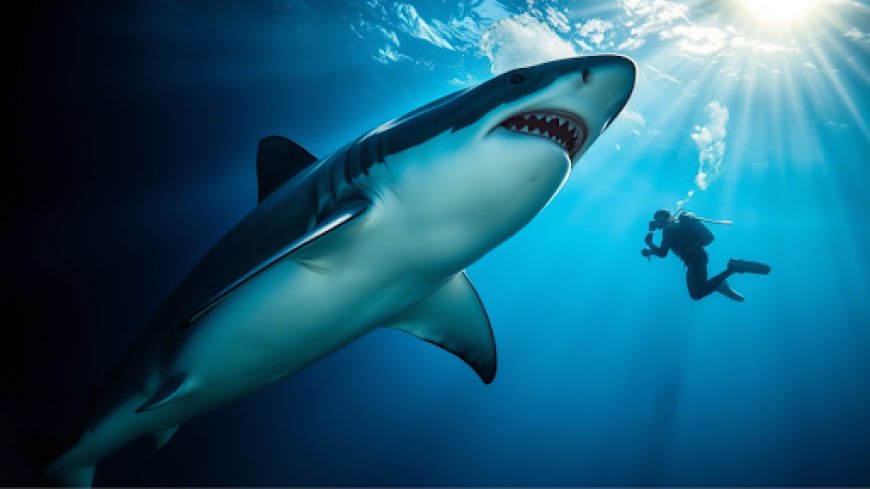Nine Tips for Photographing Great White Sharks
Sharks move fast and unpredictably. Use continuous autofocus (AI-Servo for Canon, AF-C for Nikon/Sony).

For wildlife photography enthusiasts, few subjects ignite the primal thrill and challenge quite like the great white shark. Capturing these magnificent, powerful predators in their natural domain demands respect, preparation, and specialized techniques. Moving beyond simple snapshots to create compelling, impactful wild photography photos requires strategy. Here are nine essential tips to elevate your great white shark photography:
1.Master Your Equipment in Advance
Ocean environments are unforgiving. Practice handling your DSLR or mirrorless camera in its housing on land until every control is second nature. Underwater, amidst excitement and potentially rough seas, fumbling for settings means missed shots. Ensure housing ports are spotless and O-rings meticulously maintained. Familiarity breeds confidence when the action unfolds.
2.Harness the Power of Shutter Speed
Freezing the explosive power of a breach or the subtle movement of a cruising shark demands fast shutter speeds. Aim for 1/1000th of a second or faster to eliminate motion blur. This is non-negotiable for sharp action shots. In lower light or for deliberate motion blur effects (like panning with a cruising shark), you might dip lower, but prioritize speed for most encounters.
3.Respect the Light & Shoot Up
Water absorbs light and color rapidly. Position yourself below the shark whenever safely possible. Shooting upwards towards the surface silhouette creates dramatic backlighting, emphasizes the shark's imposing size and shape against the light, and provides clearer visibility than looking down into the blue depths. This perspective is iconic for predator shots.
4.Patience is Your Primary Lens
Great whites operate on their own schedule. Expect long periods of waiting punctuated by brief, intense moments of action. Resist the urge to constantly chase; instead, find a promising spot (near a decoy or bait ball if on a responsible charter), settle in, observe behavior patterns, and be ready. The most powerful wild photography photos often come to those who wait attentively.
5.Get Close, But Know the Limits
Water reduces clarity and contrast. Physically getting closer (safely!) is always preferable to relying solely on a long lens and heavy cropping underwater, which degrades image quality. Understand the shark's behavior and the guidance of your dive team. Use the environment – kelp forests, rocky outcrops – for context, but prioritize safety and ethical distance above the shot.
6.Dial in Your Autofocus Strategy
Sharks move fast and unpredictably. Use continuous autofocus (AI-Servo for Canon, AF-C for Nikon/Sony). Employ a dynamic or zone AF area mode rather than a single point to better track the shark as it moves through the frame. Pre-focusing on a decoy or a spot where you anticipate the shark will pass can also be effective.
7.Embrace the Cold Water Reality
Great whites often frequent cooler waters. Extended time in cold water drains energy and numbs fingers, impacting your ability to operate equipment smoothly and compose thoughtfully. Invest in a high-quality, thick wetsuit (7mm+), hood, gloves, and booties. Staying warm isn't just about comfort; it's crucial for maintaining technical proficiency and safety throughout the dive.
8.Ethics are Paramount
Responsible wildlife photography is foundational. Choose operators with impeccable ethical practices – no chumming that lures sharks dangerously close to people outside cages, no touching, harassing, or baiting sharks into unnatural behaviors. Your presence should cause minimal disturbance. Respecting the animal ensures its well-being and leads to more natural, authentic wild photography photos.
9.Post-Process with Precision & Restraint
Underwater images often require careful post-processing due to color casts (blue/green dominance) and reduced contrast. Use tools like white balance adjustment, color grading (specifically targeting blues and cyans), and subtle clarity/dehaze adjustments to reveal the shark's true colors and textures. Avoid heavy-handed saturation or HDR effects that make the scene look unnatural. Aim for realism and impact.
The Eternal Student of the Deep
Photographing Carcharodon carcharias is an unparalleled privilege and a significant technical challenge. It demands meticulous preparation, respect for the animal and environment, mastery of specialized techniques, and immense patience. By focusing on shutter speed, perspective, ethical practices, and honing your skills both in and out of the water, you dramatically increase your chances of capturing not just an image, but a powerful story of the ocean's most iconic predator. Embrace the learning curve, prioritize safety and ethics, and let your passion for wildlife drive you to create images that inspire awe and conservation. The reward – that split-second capture of raw power and ancient grace – is worth every moment of preparation and patience. Now, go chase the perfect shot, responsibly.
For more information visit us : news.bangboxonline.com
What's Your Reaction?
 Like
0
Like
0
 Dislike
0
Dislike
0
 Love
0
Love
0
 Funny
0
Funny
0
 Angry
0
Angry
0
 Sad
0
Sad
0
 Wow
0
Wow
0









































